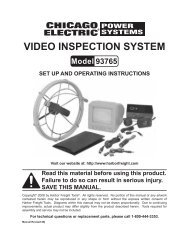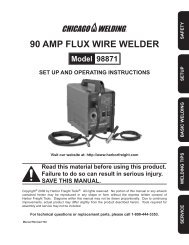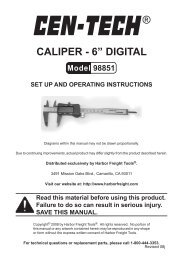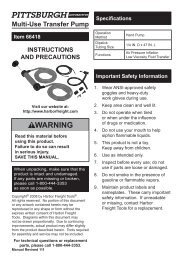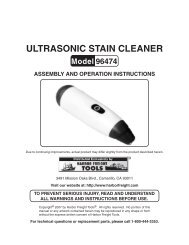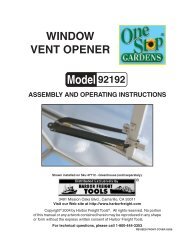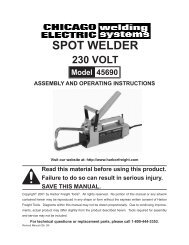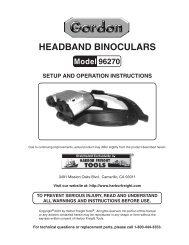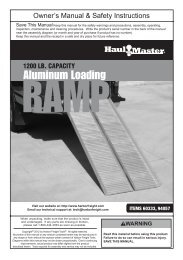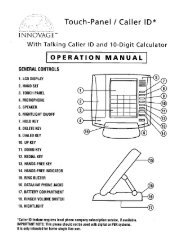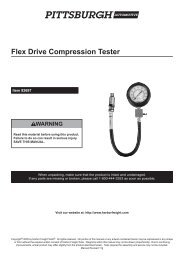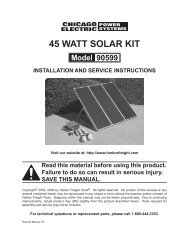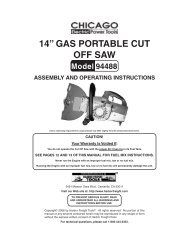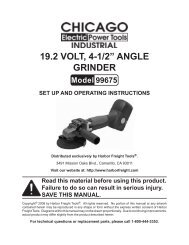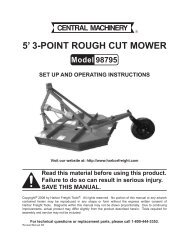6â bench grinder - Harbor Freight Tools
6â bench grinder - Harbor Freight Tools
6â bench grinder - Harbor Freight Tools
You also want an ePaper? Increase the reach of your titles
YUMPU automatically turns print PDFs into web optimized ePapers that Google loves.
6” BENCH GRINDER<br />
Model 90003<br />
ASSEMBLY AND OPERATING INSTRUCTIONS<br />
®<br />
3491 Mission Oaks Blvd., Camarillo, CA 93011<br />
Visit our Web site at: http://www.harborfreight.com<br />
Copyright 2003 by <strong>Harbor</strong> <strong>Freight</strong> <strong>Tools</strong> ® . All rights reserved. No portion of this<br />
manual or any artwork contained herein may be reproduced in any shape or form<br />
without the express written consent of <strong>Harbor</strong> <strong>Freight</strong> <strong>Tools</strong>.<br />
For technical questions, please call 1-800-444-3353.
PRODUCT SPECIFICATIONS<br />
<br />
<br />
<br />
<br />
<br />
<br />
<br />
<br />
<br />
<br />
<br />
<br />
<br />
<br />
<br />
<br />
<br />
SAVE THIS MANUAL<br />
You will need this manual for the safety warnings and precautions, assembly,<br />
operating, inspection, maintenance and cleaning procedures, parts list and assembly<br />
diagram. Keep your invoice with this manual. Write the invoice number<br />
on the inside of the front cover. Keep this manual and invoice in a safe and dry<br />
place for future reference.<br />
GENERAL SAFETY RULES<br />
WARNING!<br />
READ AND UNDERSTAND ALL INSTRUCTIONS<br />
Failure to follow all instructions listed below may result in<br />
electric shock, fire, and/or serious injury.<br />
SAVE THESE INSTRUCTIONS<br />
WORK AREA<br />
1. Keep your work area clean and well lit. Cluttered <strong>bench</strong>es and dark areas<br />
invite accidents.<br />
2. Do not operate power tools in explosive atmospheres, such as in the<br />
presence of flammable liquids, gases, or dust. Power tools create sparks<br />
which may ignite the dust or fumes.<br />
SKU 90003 PAGE 2
3. Keep bystanders, children, and visitors away while operating a power tool.<br />
Distractions can cause you to lose control. Protect others in the work area from<br />
debris such as chips and sparks. Provide barriers or shields as needed.<br />
ELECTRICAL SAFETY<br />
4. Grounded tools must be plugged into an outlet properly installed and<br />
grounded in accordance with all codes and ordinances. Never remove the<br />
grounding prong or modify the plug in any way. Do not use any adapter<br />
plugs. Check with a qualified electrician if you are in doubt as to whether<br />
the outlet is properly grounded. If the tools should electrically malfunction or<br />
break down, grounding provides a low resistance path to carry electricity away<br />
from the user.<br />
5. Double insulated tools are equipped with a polarized plug (one blade is<br />
wider than the other). This plug will fit in a polarized outlet only one way. If<br />
the plug does not fit fully in the outlet, reverse the plug. If it still does not<br />
fit, contact a qualified electrician to install a polarized outlet. Do not<br />
change the plug in any way. Double insulation eliminates the need for the<br />
three wire grounded power cord and grounded power supply system.<br />
6. Avoid body contact with grounded surfaces such as pipes, radiators,<br />
ranges, and refrigerators. There is an increased risk of electric shock if your<br />
body is grounded.<br />
7. Do not expose power tools to rain or wet conditions. Water entering a power<br />
tool will increase the risk of electric shock.<br />
8. Do not abuse the Power Cord. Never use the Power Cord to carry the tools<br />
or pull the Plug from an outlet. Keep the Power Cord away from heat, oil,<br />
sharp edges, or moving parts. Replace damaged Power Cords immediately.<br />
Damaged Power Cords increase the risk of electric shock.<br />
9. When operating a power tool outside, use an outdoor extension cord<br />
marked “W-A” or “W”. These extension cords are rated for outdoor use, and<br />
reduce the risk of electric shock.<br />
PERSONAL SAFETY<br />
10. Stay alert. Watch what you are doing, and use common sense when operating<br />
a power tool. Do not use a power tool while tired or under the influence<br />
of drugs, alcohol, or medication. A moment of inattention while operating<br />
power tools may result in serious personal injury.<br />
SKU 90003 PAGE 3
11. Dress properly. Do not wear loose clothing or jewelry. Contain long hair.<br />
Keep your hair, clothing, and gloves away from moving parts. Loose<br />
clothes, jewelry, or long hair can be caught in moving parts.<br />
12. Avoid accidental starting. Be sure the Power Switch is off before plugging<br />
in. Carrying power tools with your finger on the Power Switch, or plugging in<br />
power tools with the Power Switch on, invites accidents.<br />
13. Remove adjusting keys or wrenches before turning the power tool on. A<br />
wrench or a key that is left attached to a rotating part of the power tool may result<br />
in personal injury.<br />
14. Do not overreach. Keep proper footing and balance at all times. Proper<br />
footing and balance enables better control of the power tool in unexpected<br />
situations.<br />
15. Use safety equipment. Always wear eye protection. Dust mask, non-skid<br />
safety shoes, hard hat, or hearing protection must be used for appropriate<br />
conditions.<br />
TOOL USE AND CARE<br />
16. Use clamps (not included) or other practical ways to secure and support<br />
the workpiece to a stable platform. Holding the work by hand or against your<br />
body is unstable and may lead to loss of control.<br />
17. Do not force the tool. Use the correct tool for your application. The correct<br />
tool will do the job better and safer at the rate for which it is designed.<br />
18. Do not use the power tool if the Power Switch does not turn it on or off.<br />
Any tool that cannot be controlled with the Power Switch is dangerous and must<br />
be replaced.<br />
19. Disconnect the Power Cord Plug from the power source before making any<br />
adjustments, changing accessories, or storing the tool. Such preventive<br />
safety measures reduce the risk of starting the tool accidentally.<br />
20. Store idle tools out of reach of children and other untrained persons. <strong>Tools</strong><br />
are dangerous in the hands of untrained users.<br />
21. Maintain tools with care. Keep cutting tools sharp and clean. Properly<br />
maintained tools with a sharp cutting edge are less likely to bind and are easier<br />
to control. Do not use a damaged tool. Tag damaged tools “Do not use” until<br />
repaired.<br />
SKU 90003 PAGE 4
22. Check for misalignment or binding of moving parts, breakage of parts, and<br />
any other condition that may affect the tool’s operation. If damaged, have<br />
the tool serviced before using. Many accidents are caused by poorly maintained<br />
tools.<br />
23. Use only accessories that are recommended by the manufacturer for your<br />
model. Accessories that may be suitable for one tool may become hazardous<br />
when used on another tool.<br />
SERVICE<br />
24. Tool service must be performed only by qualified repair personnel. Service<br />
or maintenance performed by unqualified personnel could result in a risk of injury.<br />
25. When servicing a tool, use only identical replacement parts. Follow<br />
instructions in the “Inspection, Maintenance, And Cleaning” section of this<br />
manual. Use of unauthorized parts or failure to follow maintenance instructions<br />
may create a risk of electric shock or injury.<br />
SPECIFIC SAFETY RULES<br />
1. Maintain a safe working environment. Keep the work area well lit. Make sure<br />
there is adequate surrounding workspace. Always keep the work area free of<br />
obstructions, grease, oil, trash, and other debris. Do not use the Bench Grinder<br />
in areas near flammable chemicals, dusts, and vapors.<br />
2. Maintain labels and nameplates on the Bench Grinder. These carry<br />
important information. If unreadable or missing, contact <strong>Harbor</strong> <strong>Freight</strong> <strong>Tools</strong> for<br />
a replacement.<br />
3. WARNING! To avoid serious personal injury and/or property damage,<br />
always use Grinding Wheels (part #64) that are rated at 3450 RPM or<br />
greater on this particular Bench Grinder.<br />
4. Replace a cracked, broken, or excessively worn Grinding Wheel (part #64)<br />
immediately. Use only the flanges furnished with the Bench Grinder. Do<br />
not overtighten the wheel nut.<br />
5. Always wear a safety impact full face shield, hearing protection, and heavy<br />
duty work gloves when using this product. A safety impact full face shield,<br />
hearing protection, and heavy duty work gloves are available from <strong>Harbor</strong> <strong>Freight</strong><br />
<strong>Tools</strong>.<br />
6. Keep all guards in place and working properly.<br />
SKU 90003 PAGE 5
7. Always maintain a 1/16” distance or less between the Grinding Wheels<br />
(part #64) and Left and Right Tool Rests (parts #28, #32) as the diameter of<br />
the Grinding Wheels decrease with use.<br />
8. To avoid accidental electrical shock, do not allow the Power Switch<br />
(part #3) to become wet. Do not touch the Power Switch with wet hands.<br />
9. When using the Bench Grinder, always maintain a firm grip on the object<br />
being ground with both hands.<br />
10. To avoid accidental burns use caution when handling an object that is<br />
being ground. Allow sufficient time for the object to completely cool before<br />
handling.<br />
11. Always remove all adjusting keys and wrenches from the Bench Grinder<br />
before starting.<br />
12. Do not pull or carry the Bench Grinder by its Power Cord (part #4), or<br />
pull the Cord around sharp corners or edges. Do not unplug the Bench<br />
Grinder by pulling on the Cord. Keep the Cord away from heated surfaces.<br />
13. Do not force the tool. This Bench Grinder will do the work better and safer at<br />
the speed and capacity for which it is designed.<br />
14. Keep fingers and hands as far away as possible from the rotating Grinding<br />
Wheels (part #64).<br />
15. Check for damaged parts. Before using this product, carefully check that it will<br />
operate properly and perform its intended function. Check for damaged parts<br />
and any other conditions that may affect the safe operation of this product.<br />
Replace or repair damaged or worn parts immediately.<br />
16. Replacement parts and accessories. When servicing, use only identical replacement<br />
parts. Only use accessories intended for use with this product.<br />
17. Use the right product for the right job. There are certain applications for<br />
which this product was designed. Do not use small equipment, tools, or attachments<br />
to do the work of larger industrial equipment, tools, or attachments. Do<br />
not use this product for a purpose for which it was not intended.<br />
18. Stay alert. Watch what you are doing at all times. Use common sense. Do<br />
not use this product when you are tired or distracted from the job at hand.<br />
19. Do not operate this product when fatigued or under the influence of alcohol<br />
or drugs.<br />
SKU 90003 PAGE 6
22. Always turn off the Bench Grinder and unplug it from its electrical<br />
outlet before changing accessories or performing any inspection, maintenance,<br />
or cleaning procedures.<br />
23. WARNING! The warnings and cautions discussed in this manual cannot<br />
cover all possible conditions and situations that may occur. It must be under<br />
stood by the operator that common sense and caution are factors which cannot<br />
be built into this product, but must be supplied the the operator.<br />
24. WARNING! Some dust created by power sanding, sawing, grinding, drilling,<br />
and other construction activities contain chemicals known to the State of<br />
California to cause cancer, birth defects or other reproductive harm. Some<br />
examples of these chemicals are: lead from lead-based paints, crystalline silica<br />
from bricks and cement and other masonry products, arsenic and chromium from<br />
chemically treated lumber. Your risk from these exposures varies depending on<br />
how often you do this type of work. To reduce your exposure to these chemicals<br />
work in a well ventilated area, and work with approved safety equipment such as<br />
those dust masks that are specially designed to filter out microscopic particles.<br />
(California Health & Safety Code 25249.5 et seq.)<br />
25. WARNING! People with pacemakers should consult their physician(s)<br />
before using this product. Operation of electrical equipment in close proximity to<br />
a heart pacemaker could cause interference or failure of the pacemaker.<br />
GROUNDING<br />
WARNING!<br />
Improperly connecting the grounding wire can result in the risk of electric<br />
shock. Check with a qualfified electrician if you are in doubt as to whether the<br />
outlet is properly grounded. Do not modify the power cord plug provided with<br />
the tool. Never remove the grounding prong from the plug. Do not use the<br />
tool if the power cord or plug is damaged. If damaged, have it repaired by<br />
a service facility before use. If the plug will not fit the outlet, have a proper<br />
outlet installed by a qualified electrician.<br />
GROUNDED TOOLS: TOOLS WITH THREE PRONG PLUGS<br />
1. <strong>Tools</strong> marked with “Grounding Required” have a three wire cord and three prong<br />
grounding plug. The plug must be connected to a properly grounded outlet. If<br />
the tool should electrically malfunction or break down, grounding provides a low<br />
resistance path to carry electricity aways from the user, reducing the risk of<br />
electric shock. (See Figure A, next page.)<br />
SKU 90003 PAGE 7
2. The grounding prong in the plug is connected through the green wire inside the<br />
cord to the grounding system in the tool. The green wire in the cord must be the<br />
only wire connected to the tool’s grounding system and must never be attached<br />
to an electrically “live” terminal. (See Figure A.)<br />
3. Your tool must be plugged into an appropriate outlet, properly installed and<br />
grounded in accordance with all codes and ordinances. The plug and outlet<br />
should look like that in the following illustration. (See Figure A.)<br />
FIGURE A<br />
DOUBLE INSULATED TOOLS: TOOLS WITH TWO PRONG PLUGS<br />
4. <strong>Tools</strong> marked “Double Insulated” do not require grounding. They have a<br />
special double insulation system which satisfies OSHA requirements and com<br />
plies with the applicable standards of Underwriters Laboratories, Inc., the<br />
Canadian Standard Association, and the National Electrical Code.<br />
(See Figure B.)<br />
5. Double insulated tools may be used in either of the 120 volt outlets shown in the<br />
following illustration. (See Figure B.)<br />
FIGURE B<br />
SKU 90003 PAGE 8
EXTENSION CORDS<br />
1. Grounded tools require a three wire extension cord. Double Insulated tools<br />
can use either a two or three wire extension cord.<br />
2. As the distance from the supply outlet increases, you must use a heavier gauge<br />
extension cord. Using extension cords with inadequately sized wire causes a<br />
serious drop in voltage, resulting in loss of power and possible tool damage.<br />
(See Figure C, next page.)<br />
3. The smaller the gauge number of the wire, the greater the capacity of the cord.<br />
For example, a 14 gauge cord can carry a higher current than a 16 gauge cord.<br />
(See Figure C.)<br />
4. When using more than one extension cord to make up the total length, make<br />
sure each cord contains at least the minimum wire size required.<br />
(See Figure C.)<br />
5. If you are using one extension cord for more than one tool, add the nameplate<br />
amperes and use the sum to determine the required minimum cord size.<br />
(See Figure C.)<br />
6. If you are using an extension cord outdoors, make sure it is marked with the<br />
suffix “W-A” (“W” in Canada) to indicate it is acceptable for outdoor use.<br />
7. Make sure your extension cord is properly wired and in good electrical condition.<br />
Always replace a damaged extension cord or have it repaired by a qualified<br />
electrician before using it. Protect your extension cords from sharp objects,<br />
excessive heat, and damp or wet areas.<br />
<br />
<br />
<br />
<br />
<br />
<br />
<br />
<br />
<br />
<br />
<br />
<br />
<br />
<br />
<br />
<br />
<br />
<br />
<br />
<br />
<br />
<br />
<br />
<br />
<br />
FIGURE C<br />
SKU 90003 PAGE 9
SYMBOLOGY<br />
Double Insulated<br />
V ~<br />
A<br />
no xxxx/min.<br />
Canadian Standards<br />
Association<br />
Underwriters<br />
Laboratories, Inc.<br />
Volts Alternating Current<br />
Amperes<br />
No Load Revolutions<br />
per Minute (RPM)<br />
UNPACKING<br />
When unpacking, check to make sure all the parts shown on the Parts List on page 15<br />
are included. If any parts are missing or broken, please call <strong>Harbor</strong> <strong>Freight</strong> <strong>Tools</strong> at the<br />
number shown on the cover of this manual as soon as possible.<br />
ASSEMBLY INSTRUCTIONS<br />
NOTE: For additional information regarding the parts listed in the following pages, refer<br />
to the Assembly Diagram on page 16.<br />
1. WARNING! Always make sure the Power Plug (part #10) of the Bench<br />
Grinder is unplugged from its electrical outlet prior to assembly, adding any<br />
accessories, or making any adjustments to the tool.<br />
To Attach The Tool Rests:<br />
1. Align the mounting slot in the Left Tool Rest (part #28) with the two threaded<br />
mounting holes in the Left Wheel Guard (part #27). Insert two Screws with two<br />
Lock Washers (part #25) through the mounting slot in the Left Tool Rest, and<br />
loosely finger tighten the two Screws into the threaded mounting holes in the Left<br />
Wheel Guard. (See Figure D, next page.)<br />
2. Slide the Left Tool Rest (part #28) forward to within 1/16” of the Grinding Wheel<br />
(part #64). Then, firmly tighten the two Screws with Lockwashers (part #25) to<br />
secure the Left Tool Rest in place. (See Figure D.)<br />
SKU 90003 PAGE 10
3. Repeat Steps #1 and #2 to attach the Right Tool Rest (part #32) to the Right<br />
Wheel Guard (part #31). (See Figure D.)<br />
SCREW<br />
WITH<br />
LOCK WASHER<br />
(#25)<br />
LEFT WHEEL<br />
GUARD<br />
(#27)<br />
LEFT TOOL<br />
REST<br />
(#28)<br />
FIGURE D<br />
RIGHT WHEEL<br />
GUARD<br />
(#31)<br />
RIGHT TOOL<br />
REST<br />
(#32)<br />
To Attach The Spark Guards:<br />
1. Align the mounting slot in the Left Spark Guard (part #62) with the threaded<br />
mounting hole in the Left Wheel Guard (#27). Insert one Screw (part #59) with<br />
one Washer (part #60) through the mounting slot in the Left Spark Guard, and<br />
loosely finger tighten the Screw into the threaded mounting hole in the Left<br />
Wheel Guard. (See Figure E.)<br />
2. Slide the Left Spark Guard (part #62) forward to within 1/16” of the Grinding<br />
Wheel (part #64). Then, firmly tighten the Screw (part #59) with Washer<br />
(part #60) to secure the Left Spark Guard in place. (See Figure E.)<br />
3. Repeat Steps #1 and #2 to attach the Right Spark Guard (part #61) to the Right<br />
Wheel Guard (part #31). (See Figure E.)<br />
LEFT<br />
WHEEL<br />
GUARD<br />
(#27)<br />
LEFT SPARK GUARD (#62)<br />
SCREW (#59)<br />
RIGHT SPARK GUARD (#61)<br />
RIGHT<br />
WHEEL<br />
GUARD<br />
(#31)<br />
WASHER (#60)<br />
FIGURE E<br />
SKU 90003 PAGE 11
To Attach The Eye Shield Mounting Rods:<br />
1. Insert one Screw (part #48) with a Washer (part #13) through a Bracket<br />
(part #36) and the Left Eye Shield Mounting Rod (part #49). Then, firmly tighten<br />
the Screw to secure the Left Eye Shield Mounting Rod to the body of the Bench<br />
Grinder. (See Figure F.)<br />
2. Repeat Step #1 to attach the Right Eye Shield Mounting Rod (part #33) to the<br />
body of the Bench Grinder. (See Figure F.)<br />
LEFT EYE<br />
SHIELD<br />
MOUNTING<br />
ROD<br />
(#49)<br />
BRACKET (#36)<br />
BRACKET (#36)<br />
WASHER (#13)<br />
WASHER (#13)<br />
SCREW (#48) SCREW (#48)<br />
RIGHT EYE<br />
SHIELD<br />
MOUNTING<br />
ROD<br />
(#33)<br />
FIGURE F<br />
To Attach The Eye Shields:<br />
1. Loosen the Screw (part #55) on the Pressure Plate (part #50). Slide the Pressure<br />
Plate onto the Left Eye Shield Mounting Rod (part #49). Then, re-tighten<br />
the Screw so that the Eye Shield (part #26) can be moved up or down but will be<br />
tight enough to stay in place. (See Figure G, next page.)<br />
2. Repeat Step #1 to attach the remaining Eye Shield to the Right Eye Shield<br />
Mounting Rod (part #33). (See Figure G.)<br />
To Mount The Bench Grinder On A Work<strong>bench</strong>:<br />
1. WARNING! Make sure the work<strong>bench</strong> (not included) to which the Bench<br />
Grinder will be mounted is flat, level, and sturdy enough to bear the weight of the<br />
Bench Grinder and other tools and materials being used.<br />
SKU 90003 PAGE 12
EYE SHIELD (#26) EYE SHIELD (#26)<br />
SCREW<br />
(#55)<br />
PRESSURE PLATE<br />
(#50)<br />
LEFT EYE SHIELD<br />
MOUNTING ROD<br />
(#49)<br />
FIGURE G<br />
PRESSURE PLATE<br />
(#50)<br />
RIGHT EYE SHIELD<br />
MOUNTING ROD<br />
(#33)<br />
SCREW<br />
(#55)<br />
2. There are two 11/32” diameter mounting holes located on the Base (part #15) of<br />
the Bench Grinder. (See Figure H.)<br />
3. Temporarily set the Bench Grinder in the desired location on the work<strong>bench</strong>. Use<br />
the two 11/32” diameter mounting holes on the Bench Grinder as templates to<br />
mark where two 11/32” diameter holes will be drilled through the top of the work<strong>bench</strong>.<br />
Once marked, remove the Bench Grinder.<br />
4. Where previously marked, drill the two 11/32” holes through the top of the work<strong>bench</strong>.<br />
5. Set the Bench Grinder back on the work<strong>bench</strong>, and align the two mounting holes<br />
on the Bench Grinder with the two previously drilled holes in the work<strong>bench</strong>.<br />
Then secure the Bench Grinder to the work<strong>bench</strong>, using two 11/32” diameter<br />
Bolts of appropriate length, two Lock Washers, and two Nuts (none included).<br />
EYE SHIELD<br />
(#26) EYE SHIELD<br />
(#26)<br />
GRINDING WHEEL<br />
(#64)<br />
LEFT<br />
TOOL REST<br />
(#28)<br />
GRINDING WHEEL<br />
(#64)<br />
RIGHT<br />
TOOL REST<br />
(#32)<br />
11/32” MOUNTING HOLE 11/32” MOUNTING HOLE<br />
POWER SWITCH (#3)<br />
FIGURE H<br />
SKU 90003 PAGE 13
OPERATING INSTRUCTIONS<br />
1. WARNING! Prior to using the Bench Grinder, make sure to wear ANSI approved<br />
safety glasses, full face safety impact shield, and heavy duty work gloves. Also,<br />
always adjust the two Eye Shields (part #26) directly in line between your eyes<br />
and the object being ground. (See Figure H.) Always keep wheel covers in<br />
place when using the Bench Grinder.<br />
2. Plug the Power Cord Plug (part #10) into the nearest grounded, 120 volt, electrical<br />
outlet. Then, turn the Power Switch (part #3) to its “ON” position and allow<br />
the Grinding Wheels (part #64) to spin up to full speed. (See Figure H.)<br />
3. Hold the workpiece being ground with both hands, taking care to keep fingers<br />
and hands away from the spinning Grinding Wheels (part #64). (See Figure H.)<br />
4. Place the workpiece on the Left or Right Tool Rest (parts #28, #32), applying<br />
moderate pressure on the workpiece and keeping it moving to the left and right at<br />
an even pace for smooth grinding. NOTE: Feeding the workpiece too hard into<br />
the Grinding Wheel (part #64) can overheat the Motor and prematurely wear<br />
down the Grinding Wheel. (See Figure H.)<br />
5. IMPORTANT: Keep a tray nearby filled with water, and dip the workpiece into the<br />
water regularly to prevent overheating. Overheating can weaken metals.<br />
6. Once the grinding job is completed, turn the Power Switch (part #3) to its “OFF”<br />
position and allow the Grinding Wheels (part #64) to stop on their own. Unplug<br />
the Bench Grinder when it is not in use. (See Figure H.)<br />
7. Place the workpiece in the tray of water and allow the workpiece to completely<br />
cool before handling.<br />
INSPECTION, MAINTENANCE, AND CLEANING<br />
1. WARNING! Make sure the Power Switch (part #3) of the Bench Grinder is<br />
in its “OFF” position and that the tool is unplugged from its electrical outlet before<br />
performing any inspection, maintenance, or cleaning procedures.<br />
2. BEFORE EACH USE, inspect the general condition of the Bench Grinder.<br />
Check for loose screws, misalignment or binding of moving parts, damaged<br />
electrical wiring, cracked, chipped, or damaged Grinding Wheels (part #64), and<br />
any other condition that may affect its safe operation. If abnormal noise or vibration<br />
occurs, have the problem corrected before further use.<br />
Do not use damaged equipment.<br />
SKU 90003 PAGE 14
3. TO CLEAN: Use vaccum or a clean cloth and mild detergent to clean the body of<br />
the Bench Grinder. Do not use solvents. Do not immerse any part of the tool in<br />
liquid.<br />
PARTS LIST<br />
<br />
<br />
<br />
<br />
<br />
<br />
<br />
<br />
<br />
<br />
<br />
<br />
<br />
<br />
<br />
<br />
<br />
<br />
<br />
<br />
<br />
<br />
<br />
<br />
<br />
<br />
<br />
<br />
<br />
<br />
<br />
<br />
<br />
NOTE: Some parts are listed and shown for illustration purposes only, and are not<br />
available individually as replacement parts.<br />
SKU 90003 PAGE 15
ASSEMBLY DIAGRAM<br />
26 58<br />
57<br />
58<br />
53 52<br />
13<br />
54<br />
48 62 59<br />
48<br />
50<br />
36<br />
60<br />
55 63<br />
28<br />
12<br />
24<br />
51 64<br />
13<br />
27<br />
5<br />
25<br />
19<br />
23 20<br />
25<br />
24<br />
22<br />
10<br />
20 21 18<br />
4<br />
2<br />
45<br />
15<br />
44<br />
14<br />
1<br />
17<br />
5<br />
16 37<br />
41<br />
42<br />
43<br />
44<br />
45<br />
38<br />
8<br />
34<br />
48<br />
9<br />
7<br />
40<br />
39<br />
3<br />
6<br />
44,45<br />
35<br />
47<br />
NOTE: Some parts are listed and shown for illustration purposes only, and are not<br />
available individually as replacement parts.<br />
33<br />
36<br />
13<br />
51 5453 61<br />
46<br />
29<br />
50<br />
52<br />
59,60<br />
30<br />
55<br />
26<br />
56<br />
57<br />
63<br />
24<br />
50<br />
18<br />
31<br />
40<br />
25<br />
32<br />
12<br />
13<br />
PLEASE READ THE FOLLOWING CAREFULLY<br />
THE MANUFACTURER AND/OR DISTRIBUTOR HAS PROVIDED THE PARTS LIST AND ASSEMBLY<br />
DIAGRAM IN THIS MANUAL AS A REFERENCE TOOL ONLY. NEITHER THE MANUFACTURER OR<br />
DISTRIBUTOR MAKES ANY REPRESENTATION OR WARRANTY OF ANY KIND TO THE BUYER THAT<br />
HE OR SHE IS QUALIFIED TO MAKE ANY REPAIRS TO THE PRODUCT, OR THAT HE OR SHE IS<br />
QUALIFIED TO REPLACE ANY PARTS OF THE PRODUCT. IN FACT, THE MANUFACTUER AND/OR<br />
DISTRIBUTOR EXPRESSLY STATES THAT ALL REPAIRS AND PARTS REPLACEMENTS SHOULD BE<br />
UNDERTAKEN BY CERTIFIED AND LICENSED TECHNICIANS, AND NOT BY THE BUYER. THE BUYER<br />
ASSUMES ALL RISK AND LIABILITY ARISING OUT OF HIS OR HER REPAIRS TO THE ORIGINAL<br />
PRODUCT OR REPLACEMENT PARTS THERETO, OR ARISING OUT OF HIS OR HER INSTALLA-<br />
TION OF REPLACEMENT PARTS THERETO.<br />
SKU 90003 PAGE 16



